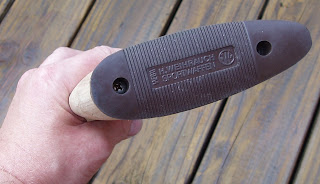
The rubber flexes away from the sander too much.

Here's a few minutes trying to fit the toe. It's curved...

Not good. Most people I know who fit rubber recoil pads use a disc sander. I was trying to avoid working inside the house--mainly because the rubber dust gets everywhere.

Out of sheer curiosity, I mounted a sanding drum into the 3-jaw chuck on the Taig lathe, and profiled the butt pad by eye in about 60 seconds. Likely not the way to do it if you're on that fourth cup of espresso.

Looked pretty good. I sanded the stock down to 220 grit.

The pad is pretty dusty from the wood sanding. It'll get cleaned off later.

After the sanding, a rag dampened with some distilled water is run across the wood. As the water evaporates, it lifts wood "whiskers" from the sanding. Allow the stock to completely dry then sand again with 220 grit to remove the fuzzies.

A coat of a redwood oil based stain. Given my past history staining vintage Crosman stocks, I opted for a stain with a lot of pigment. My hope was that the redwood stain would give enough color to the wood to make it look like cherry. Why not just use cherry stain? I tried that. Cherry colored stain makes these stocks turn light pink. And I really wouldn't be using the 147 much if it looked like a pink underbelly...

The forend looks like a brick. Functional, but a bit too blocky.

Put the sanding drum back to work reshaping the front end.

Softened up the nose.

I'm probably going to regret working these as two separate pieces.

Redwood stained. The through holes I drilled (in Part 1) to get the roll pins out really stand out in this pic.

And then I decided to do more work. The metal on the 147 BP was in so-so shape cosmetically. I completely disassembled the gun and started by stripping the old paint off the trigger housing assembly with a wire wheel.

The paint on many vintage Crosman trigger guards take a beating every time the guns are disassembled as they're pulled through the wood stocks.

Pump arm, barrel assembly, pump tube, trigger guard are all looking tired. The bluing had all gone plum. Pump guns get a lot of handling by nature--especially by the time they turn 43 years old.

Epoxy spray paint from Rust-Oleum. I've used this stuff before on the compression tube of a Baikal IZH-46M. The 46M tube was thinly blued when new and didn't age well. Hit it with two coats of this and it looks factory finished and incredibly tough.

Downside? The drying time. I could bake it and get it over with sooner, but my wife would probably not take kindly to gun parts in the oven. I'll give it a couple days at least. If it holds up for the next ten years, what's 48 or so hours anyway?

Some .177 cal felt cleaning pellets.

Only need two...

One to keep paint out of the muzzle...

And another to plug the breech.

Don't want paint inside the compression tube. A piece of 1/2" PVC pipe fits the ID of the tube perfectly.

Painted everything and hung to dry. Also ended up painting the end plugs and front sight.

One coat of Birchwood Casey Sealer and Filler and I rubbed the stock down with 0000 steel wool.

Most of the grain is filled now. Hopefully several coats of Tru-Oil will finish the job.

A pretty good slathering. Now, some drying time and several more coats.
Still more to come...

































